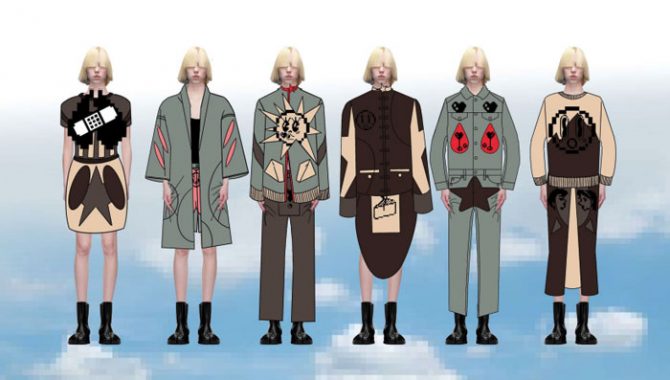—-
To stay in the loop with the latest features, news and interviews from the creative community around licensing, sign up to our weekly newsletter here

Students at Nottingham Trent University were invited to create a collection of emoji apparel, spanning eight to 10 pieces for womenswear, menswear or unisex.
Earlier this year, emoji and WildBrain CPLG launched a design competition for fashion design students at Nottingham Trent University.
Students were invited to create a collection of emoji apparel, spanning eight to 10 pieces for womenswear, menswear or unisex. Judges were looking for a fresh, innovative and fashion-focused approach, which showed thinking outside of the box when it came to design.
First prize went to Mingfei Liu, whose playful edge using a fresh new colour palette was a hit with the judges.

Coming in second was Poppy Wilson, whose collection boasted a graffiti style and charity tie-in.

Georgia Oliver placed third for her entry which demonstrated a thorough understanding of the brand and market, with designs that had a huge commercial appeal.

The three winners each received a cash prize, with Mingfei also receiving the opportunity for a placement week with the WildBrain CPLG creative services team.
To find out more about the initiative, we spoke with emoji’s Marco Hüsges, WildBrain CPLG’s Michael Ogunseitan and Nottingham Trent University’s Emma Prince.
 Marco Hüsges, CEO/Founder of The emoji Company
Marco Hüsges, CEO/Founder of The emoji Company
Marco, thanks for making time. First off, why launch this competition?
This year sees the emoji brand celebrate its 10th anniversary. These digital icons have fast become the world’s global language, with more than 10 billion being used daily via social messenger applications, email or SMS services. The great thing about emoji brand icons is that they really do speak a thousand words. So, to celebrate the 10 year anniversary, we wanted to tap into the next generation’s interpretation of our brand. What do they want to say and how will they say it?
What were you looking for from students? What makes a design sing for you?
We are a brand driven by creativity, so we were looking for a fresh perspective from up-and-coming creatives. As well as seeking their unique interpretation of the emoji brand icons, we were also looking at how the students could carry that through to experiment with new colour-palettes and shapes – to see their vision of the future of emoji fashion.
What advice would you give to the next generation of creatives entering the industry?
Be open and interested to learn about the industry, but always be bold enough to challenge the status quo.
10 years in, what’s the key to keeping the emoji brand fresh and relevant?
Creativity is key. At the emoji company, we release at least 12 new asset packs per year; we now have over 180 style guides in our asset bank. This is key to driving new business for us, alongside seeking out best-in-class collaboration partners and licensees who share our vision. We’ve seen some stand-out creative partnerships and products for the brand recently, including with Custom Lab in France, Too Many Shoes in China, a partnership for salty snacks with Lorenz Bahlsen, Brühwurstpastete with Eggelbusch, and a multi-territory partnership with Pierre Fabre for dental care products.
 Michael Ogunseitan, Creative Services Director, WildBrain CPLG
Michael Ogunseitan, Creative Services Director, WildBrain CPLG
Michael, great to catch up. First off, why is it important to encourage new talent into the creative side of licensing through initiatives like this?
The licensing industry never stands still – we are always trying to be one step ahead of consumers and trends – and tapping into young talent is vital for the future of our industry. Finding fresh perspectives and designers who can stretch the boundaries can be challenging, but what I love about working with new talent such as the NTU students is being able to nurture and encourage that mindset.
The creative side of licensing is also a fascinating part of the industry, and it’s important to encourage upcoming talent into the industry to bring diverse and new perspectives. WildBrain CPLG does a lot of its creative services in-house with a holistic approach to brand-building, which is a real strength; campaigns and products can be so much more impactful when partners and creative teams work together closely.
The emoji brand is 10 years old. What’s the key to putting a fresh spin on IP that’s already had lots of licensing activity?
The emoji brand is an evergreen property that has evolved in line with popular culture, and that’s key to keeping the brand relevant. Initially, the business was focused on a core set of icons, but as the language of emoji has evolved, so have the opportunities to make the brand more wide-ranging and diverse.
With a decade of heritage, emoji is now a lifestyle brand, with universal appeal across broad demographics worldwide, having become a language unto itself and huge part of how people express themselves. The emoji brand really lends itself well to playful, colourful partnerships, and we have seen some great collaborations, such as with IDO in Italy, where the brand won the Licensing Award at the Bologna Fair for the best Kids & Teens Apparel project, a global print on demand concept with Bershka and an apparel range for Don’t Call Me Jennyfer in France.
You were one of the judges for the competition. What did you look for from submissions?
We were looking for a unique response to the brief – from conceptual exploration, through to interpretation of the emoji brand icons, commercial appeal, and then a cohesive final line-up of designs. More than anything, we wanted to be inspired and excited by what was presented.
Why do you feel the emoji brand is still thriving as a brand 10 years on?
The emoji brand is a universal brand that truly speaks to everyone – no matter what age they are or where they live. Alongside this, we are seeing the role of these icons in our lives is constantly evolving, and with the continued focus the brand has on creative, there are no limits to where we can go together.
 Emma Prince, Course Leader, NTU’s BA Fashion Design
Emma Prince, Course Leader, NTU’s BA Fashion Design
Emma, how important is it for your students to get these kinds of real-world opportunities to work with brands?
It is so important for our students to engage in practical, real-world business opportunities. It’s key for them to explore opportunities that give them a chance to work outside of their comfort zone and present ideas to an industry team, alongside learning about the world of licensing.
Does the world of licensing feature on the course?
We introduce our students to the world of licensing through live briefs, just as we have done with the emoji brand this year. Licensing is such an important and growing industry, and it’s an avenue that students are not always aware of when they embark on their design journeys.
What made this emoji brand brief an exciting one for students?
The emoji brand is such an iconic brand, so our students were thrilled to be able to work with the brand’s assets and develop some really cool concepts based on the brief – ‘United by Emotions.’ They were also encouraged to develop new emoji brand icons alongside their graphics, fabric samples and silhouettes. We are grateful for the emoji company and WildBrain CPLG teams who have given some fantastic feedback, and we are excited to see how this initiative develops further.
Enter your details to receive Brands Untapped updates & news.